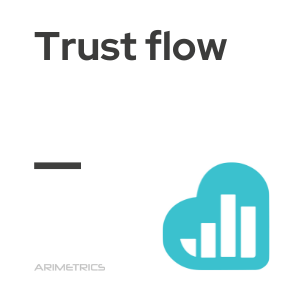
Definition:
Trust Flow is an SEO metric used by companies like Majestic and Moz to assess the quality of an address or domain based on the trust and quality level of the sites linking to it through backlinks. These tools are widely used to measure the authority and relevance of a web domain. This concept has been present on the internet for years, but it can only be measured with the appropriate tools.
Its importance has grown due to the current priorities of Google algorithms and other search engines, which value quality over quantity. The reputation of the website and the quality of the links are extremely important.
What is Trust Flow used for?
Trust Flow allows to know the quality of a site based on the quality of the sites linking to it through backlinks. It is essential for SEO and linkbuilding strategies, and for assessing whether you are improving your reputation on Google. Experts use this metric to decide whether to get links from a particular website, based on its trust level. It also helps to improve the reputation of the site itself, making it a resource that others turn to for growth.
How to calculate the Trust Flow of a page
To calculate the Trust Flow of a page, SEO analysis tools are required. There are sites that offer limited checks for free, but you generally need to provide data. The score ranges from 0 to 100, with 0 being the worst and 100 being the best.
How to increase the Trust Flow of a web page
Improving the Trust Flow of a site increases its positioning capacity. This value is not absolute and depends on the field of each web page. For example, a page may have great influence in one area and little in another. A marketing-SEO link will benefit a marketing page dedicated to the sale of office supplies.
To increase Trust Flow, it is important to get links from other pages with similar content to the home page and which have a higher Trust Flow. In addition, the position of the link is crucial; links within the text are more relevant than those located in footers or headers.
- Collaborate with trusted websites in the same niche to get quality links. This can include guest posting, where you write articles for other sites in exchange for a backlink.
- Create valuable and relevant content that attracts natural links from other sites. Content such as case studies, original research, infographics and detailed guides tend to receive more links.
- Perform regular link audits to identify and remove toxic or low-quality links that may be detrimental to Trust Flow. SEO analysis tools can help detect these links.
- Participate in industry-related forums and communities to build relationships and get organic links. Active participation can lead to mentions and links from relevant sites.
- Optimize the internal link structure of the site to improve Trust Flow distribution. Ensuring that the most important pages are well linked internally can help to better distribute authority.
- Encourage mentions in recognized media and blogs, which can significantly increase Trust Flow thanks to the high authority of these sites.
- Establish relationships with influencers and opinion leaders in the industry to obtain recommendations and links from their platforms.
- Utilize digital PR strategies to gain coverage and links from relevant news sites and blogs. This includes creating press releases and participating in industry events.
